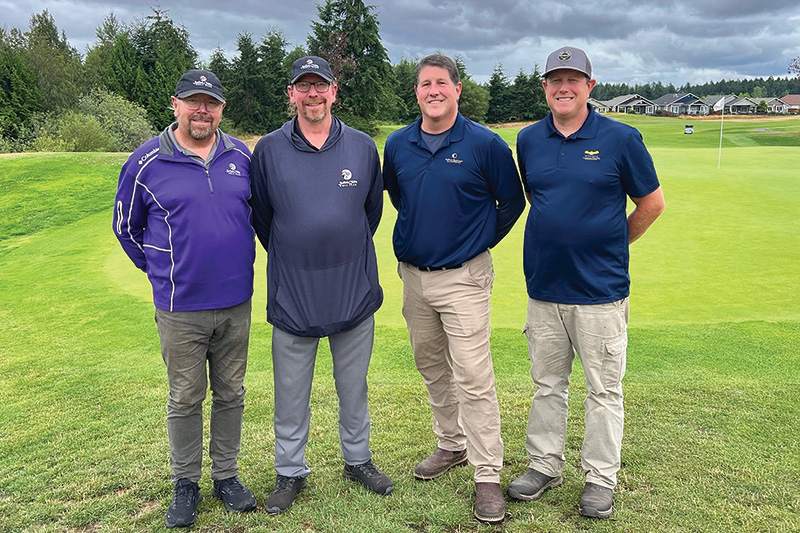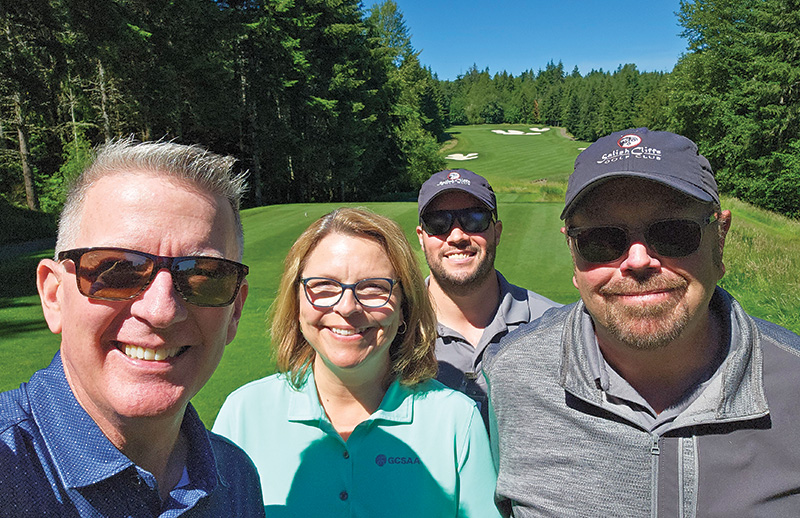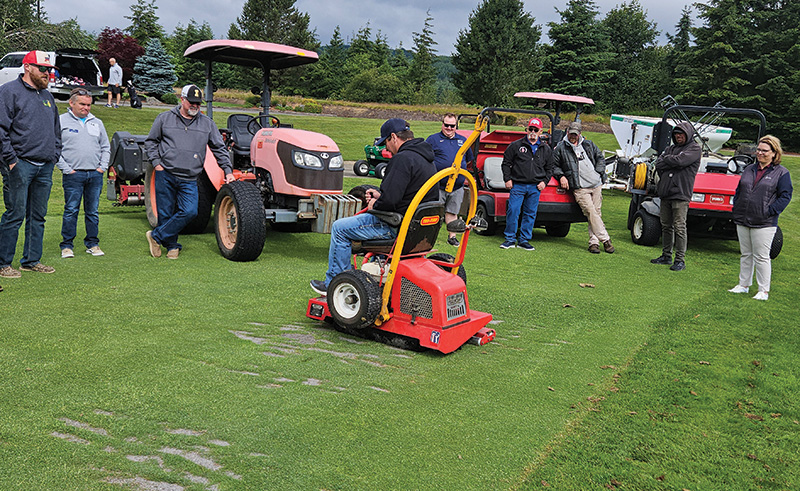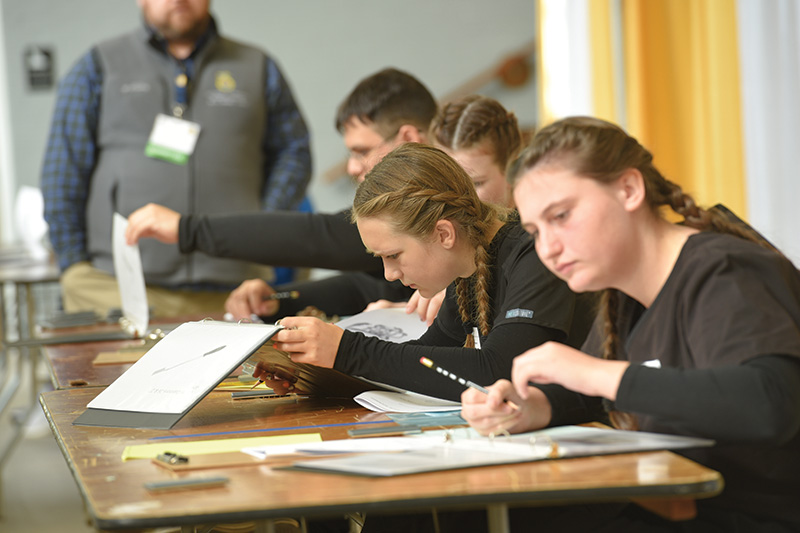
Bob Pearsall (from left), his brother, Mike, and his brothers-in-law Rick and Phil Hancock. Bob, Rick and Phil are superintendents in southwest Washington, and Mike is Bob’s assistant. Photo courtesy Bob Pearsall
Bob Pearsall says he owes his life as a golf course superintendent to the National FFA Organization, formerly Future Farmers of America. In fact, so does his brother. And both of his brothers-in-law.
“Turf is in all of our blood,” says Pearsall. “It just trickled down into all four of us, first through FFA. Thanksgiving is a real blast because all we talk about is turf.”
Pearsall, the superintendent of Salish Cliffs Golf Course in Shelton, Wash., says it was repeated conversations with his FFA teacher in high school years ago — as well as his brother’s shared interest in turf — that ultimately led him to find his passion in golf course management.
“I didn’t really have any direction. I knew that I wanted to work outside,” says Pearsall, a 29-year GCSAA member. “Our dad is a farmer and had my brother and I go into FFA and ag. For a while, I kind of wound up doing the poultry route.”
“I remember our ag teacher pressing me, ‘What are you going to do with your life, what are you going to do with your life?’ He just kept pressing me,” says Pearsall. “Ag is not just cattle and poultry — there’s turf, too. When I found turf, I was like ‘This is IT. I’ve found something I can be passionate about.’”
FFA is known for helping high school students find and pursue a career path based on their interests. It used to be known as Future Farmers of America but has more recently diversified beyond agriculture to include broader topics in business and leadership. Each local chapter of FFA has teachers (often called ag teachers) in place in high schools who mentor participating students — currently numbering more than 900,000 kids — along a career path of a student’s choice from a wide variety offered by the state and national FFA framework.
It was actually Pearsall’s brother, Mike, who first found turf through FFA and helped Bob make the connection. For most of 34 years now, they’ve worked together, Bob as the superintendent and Mike as his assistant, most recently for 14 years at Salish Cliffs.
And how did Bob’s brothers-in-law come to be superintendents, too? A neighbor boy, Rick Hancock — and later his brother, Phil — came to work for Bob at his course and learned to love turf, too. And, well, Bob would eventually meet those boys’ sister, Leslie, and marry her — and voila, four family members all in the turf trade in Washington state. Phil Hancock is superintendent at The Golf Club at Hawks Prairie in University Place and is a seven-year GCSAA member. Rick Hancock is now superintendent at Indian Summer Golf & Country Club in Olympia and is a 28-year GCSAA member.

From left, David Phipps and Leann Cooper of GCSAA. At right is Bob Pearsall, superintendent at Salish Cliffs Golf Course and his assistant (at back), Eric Dowd. Photos by David Phipps
Creating a turfgrass path with FFA
Bob Pearsall recently had a full-circle moment with FFA during an industry tour organized by the GCSAA as part of its workforce development efforts.
When the tour stopped at his course, Salish Cliffs, among those he welcomed were the Washington Association of Agricultural Educators, many of whom are FFA teachers. He shared with the group the key importance of FFA in his life and career trajectory, as well as that of his brother and brothers-in-law.
“I am a golf course superintendent because of FFA. It’s all only because the FFA teachers did what they did. They kind of got this ball rolling for all four of us,” Pearsall says. “The only reason I do what I do is because of the FFA.”
Fortunate as it was, the four boys’ path from FFA inspiration to careers in turf is perhaps an unlikely one — at least for now. That’s because, until now, FFA hasn’t had an official turfgrass program — culminating in what’s known in FFA as a Career Development Event (CDE) — within its own structure.
However, GCSAA, FFA and several other stakeholder organizations have been working to change that, says Leann Cooper, GCSAA Director of First Green and Workforce Development. And just last month, GCSAA and FFA announced the first National Turfgrass Science Invitational Event (akin to a CDE) will be held next year — with the goal of making experiences like the Pearsall family’s much more common.
“Like Bob Pearsall’s experience shows, FFA can be a powerful influence in helping kids realize early on that turfgrass science and being a golf course superintendent is a viable career choice for them,” Cooper says. “But until now there has been no officially recognized event for FFA students to participate in nationally. These competitions are important because they influence what is being taught in the high schools. What we want to do is help build that path.”
To that end, a working group representing GCSAA, the Sports Field Management Association, USGA and turfgrass college professors nationwide worked together to formulate the essential elements of a national event centered around turfgrass science that could secure FFA’s endorsement, Cooper says.
In less than a year working together, the working group formulated the essential elements needed. Namely: a turfgrass high school curriculum, practicums and study guidelines, along with the national event and career pathways.
Bringing everybody together eventually included bringing an FFA representative into the fold earlier this year to introduce FFA to the working group’s efforts on the initiative. Among the ideas hatched was to host the national competition element with the endorsement of the FFA.
“In FFA, the culmination of a student’s efforts is the national competition, or what’s known in FFA as a Career Development Event, or CDE,” Cooper says. “With that, the students will have a major goal to aim for and the career pathway through turfgrass science will be established.”

A recent industry tour organized by GCSAA as part of its workforce development efforts included a stop at Bob Pearsall’s course, Salish Cliffs. Among those he welcomed were the Washington Association of Agricultural Educators, many of whom are FFA teachers. He shared with the group the key importance of FFA in his life and career trajectory, as well as that of his brother and brothers-in-law.
“Toughest day in turf”
It was decided that the initiative’s first national competition in turfgrass science will be held in February at GCSAA’s Conference and Trade Show in 2025, Cooper says.
“At GCSAA’s conference, we’ll have stations set up for the test where they will have turfgrass identification, soil identification, equipment identification. They may also have to demonstrate that they can cut a cup, or take a moisture reading, or spreader calibration, or green speed measurement,” Cooper says. “So, the students will step through each of the stations showing they know how to do these things. The kids won’t know going in what will be tested so they will have to study a little bit of it all to be ready for whichever ones are tested.”
The second year’s competition will then be at the Sports Field Managers Association’s 2026 national conference, alternating each year thereafter with GCSAA’s national conference, says Carson Letot, USGA’s representative on the working group as USGA Greenkeeper Apprenticeship Program coordinator.
“Our goal is that this will be a really rigorous contest,” Letot says. “We are pushing forward that this will be the ‘Toughest Day in Turf’ because we want the students to be pushed and the winners to feel like they’ve actually accomplished a good deal.”
So far, the plan is to have students start by taking a written test on turf knowledge basics, he says. “Then they’ll engage in case studies in turf — they’ll be assigned a topic, and they’ll have half an hour to prepare a defense and deliver it in front of judges,” Letot says. “And then everybody will load up on a bus and we’ll head to a golf course in San Diego, where the students will compete in 10 practicums.”
Four practicums will be on identification of tools, grasses, weeds, diseases and bugs, Letot says. The other six practicums will be hands-on, skills-based activities like setting tees and cutting cups, calibrating fertilizer spreaders, checking green speeds, moisture sensing and the like.
“The idea is that, by the time they are done, they will have exhausted every last ounce of knowledge they have in turf. And that they are not only using their brains but hands as well,” Letot says.
First of its kind
The collaborative effort to create a contest mirroring FFA’s structure is unique and the first nationwide as far as FFA is aware, says Will Waidelich, program revisions specialist at FFA.
“This is the first of its kind. Until this year and with this initiative, it was not a possibility” to host such an FFA-affiliated event, says Waidelich, who now joins the working group calls to help develop its plans. He says it was a natural fit that GCSAA and SFMA host the national competitions themselves, working with FFA.
“Here’s our thinking: We host most of (FFA’s) events at our national convention in late (fall) in Indianapolis. The timing of our event doesn’t change, but it doesn’t mean it’s the greatest time to have (the turfgrass) industry showcase students’ activities,” he says. “The GCSAA’s event being in a hotter climate with the golf courses still open, it makes complete sense to us to endorse an activity that fits the industry better.”
“It also makes sense to be taking our students to the industry event where they can learn more about the industry themselves. What better place to learn about the industry than to go to the industry event and meet people in the industry that could be future employers, and maybe figure out what niche in that career area they might fit into?” Waidelich says.
The 2025 National Turfgrass Science Invitational is endorsed by FFA and open to FFA members. Registration is now open at gcsaaconference.com/gcsaa-turfgrass-science. The winners of the competition will be announced Feb. 5 during the GCSAA Conference and Trade Show.
“This collaboration between GCSAA and FFA gives high school students the chance to see the career opportunities that exist in the turf industry,” GCSAA CEO Rhett Evans says. “We are looking forward to hosting the invitational and continuing to collaborate with FFA in the future.”

FFA students participate in a Career Development Event, or CDE, which is the culminating event for each FFA career track. The inaugural National Turfgrass Science Invitational will be held at GCSAA’s Conference and Tradeshow in February 2025 with the endorsement of FFA. Photo courtesy of FFA
Early intervention to improve retention
Ultimately the aim of the initiative is to pique high schoolers’ interest in turf science earlier on and, by doing so, get them more invested in turf as a dedicated career choice, says Cooper. Currently, she says, recruiting and retaining staff in the turf industry is a challenge.
“Recruiting and retaining labor to fill essential roles remains a top issue for our members,” Cooper says.
“Raising awareness of careers in the golf industry is part of GCSAA’s strategy to help fill the labor pipeline. Through GCSAA’s First Green program, our interactions with national FFA and state FFA Chapters, our commitment to host the inaugural National Turfgrass Science Invitational in San Diego and other programs, GCSAA is leading the way in youth outreach and engagement,” she says.
Bob Pearsall says his course in Washington has a tough time with recruiting and retention. “A really tough time. We used to have the ag teacher here that was at my high school bring students out once a year, but when he retired, that just kind of went away,” he says. He thought the collaborative workforce initiative sounded promising.
“Now we just seem to be teaching employees how to do the jobs,” Pearsall says. “We’re kind of missing that middle part, where they go to a turf school to be an irrigation technician or a mechanic. I know they’re out there, but we need to do a little bit better job at the grassroots.”
Phil Cauthon (pcauthon@gcsaa.org) is GCM’s managing editor.